The Protective Effect of Xanthohumol on the Content of Selected Elements in the Bone Tissue for Exposed Japanese Quails to TCDD
Abstract
1. Introduction
2. Materials and Methods
2.1. Animals and Experimental Groups
2.2. Chemical Substances Used in the Experiment
2.3. Determination of the Mineral Composition of the Cranial Vault and Hind Limb Bone of Examined Animals
2.3.1. Mineralization of Bone Tissue Samples
2.3.2. Determination of the Concentration of Calcium, Phosphorus, Magnesium, Zinc, and Iron in the Skull Bone and Hind Limb of the Tested Birds
2.3.3. Statistical Analysis
3. Results
3.1. Calcium
3.2. Phosphorus
3.3. Magnesium
3.4. Zinc
3.5. Iron
4. Discussion
5. Conclusions
- The administration of 2,3,7,8-tetrachlorodibenzo-p-dioxin in Japanese quails at a low dose causes more dynamic changes in the concentration of elements in bone in comparison to a higher dose of dioxin. For most bioelements (P, Mg, Zn, Fe), there is a sharp decrease in their content noticed, except for calcium, whose concentration increased significantly.
- Higher doses of the XN cause the linear increase in the concentrations of phosphorus and iron in the bone of the hind limb, and calcium in the bones of cranial vault. Most often, increasing the dose of xanthohumol led to a linear decrease in the content of bioelements.
- The use of dioxin and xanthohumol in Japanese quails together in various doses influenced the content of phosphorus, magnesium, zinc, and iron in the research material.
Author Contributions
Funding
Acknowledgments
Conflicts of Interest
References
- Marinković, N.; Pašalić, D.; Ferenčak, G.; Gršković, B.; Rukavina, A. Dioxins and Human Toxicity. Arch. Ind. Hyg. Toxicol. 2010, 61, 445–453. [Google Scholar] [CrossRef] [PubMed]
- Shibamoto, T.; Yasuhara, A.; Katami, T. Dioxin formation from waste incineration. Rev. Environ. Contam. Toxicol. 2007, 190, 1–41. [Google Scholar] [PubMed]
- Zhu, J.; Hirai, Y.; Sakai, S.; Zheng, M. Potential source and emission analysis of polychlorinated dibenzo-p-dioxins and polychlorinated dibenzofurans in China. Chemosphere 2008, 73, 72–77. [Google Scholar] [CrossRef] [PubMed]
- Dobrzyński, M.; Pezowicz, C.; Tomanik, M.; Kuropka, P.; Dudek, K.; Fita, K.; Styczynska, M.; Wiglusz, R.J. Modulating effect of selected pharmaceuticals on bone in female rats exposed to 2,3,7,8- tetrachlorodibenzo-p-dioxin (TCDD). RSC Adv. 2018, 8, 27537. [Google Scholar] [CrossRef]
- Gostomska-Pampuch, K.; Ostrowska, A.; Kuropka, P.; Dobrzyński, M.; Ziółkowski, P.; Kowalczyk, A.; Łukaszewicz, E.; Gamian, A.; Całkosiński, I. Protective effects of levamisole, acetylsalicylic acid, and alpha-tocopherol against dioxin toxicity measured as the expression of AhR and COX-2 in a chicken embryo model. Histochem. Cell Biol. 2017, 147, 523–536. [Google Scholar] [CrossRef]
- Calkosinski, I.; Rosinczuk-Tonderys, J.; Dobrzynski, M.; Pałka, Ł.; Bazan, J. Occurrence of disseminated intravascular coagulation in 2,3,7,8-tetrachlorodibenzo-p-dioxin-induced pneumonia in the rat neurobiology of respiration. Adv. Exp. Med. Biol. 2013, 788, 283–292. [Google Scholar]
- Boffetta, P.; Mundt, K.; Adami, H.; Cole, P.; Mandel, J. TCDD and cancer: A critical review of epidemiologic studies. Crit. Rev. Toxicol. 2011, 41, 622–636. [Google Scholar] [CrossRef]
- Brouwer, A.; Ahlborg, U.G.; Rolaf ven Leeuwen, F.X.; Feeley, M.M. Report of the WHO working group on the assessment of health risks for human infants from exposure to PCDDS, PCDFS and PCBS. Chemosphere 1998, 37, 1627–1643. [Google Scholar] [CrossRef]
- Guo, Y.L.; Lambert, G.H.; Hsu, C.C.; Hsu, M.M.L. Yucheng: Health effects of prenatal exposure to polychlorinated biphenyls and dibenzofurans. Int. Arch. Occup. Environ. Health 2004, 77, 153–158. [Google Scholar] [CrossRef]
- Herlin, M.; Kalantari, F.; Stern, N.; Sand, S.; Larsson, S.; Viluksela, M.; Tuomisto, J.T.; Tuomisto, J.; Tuukkanen, J.; Jämsä, T.; et al. Quantitative characterization of changes in bone geometry, mineral density and biomechanical properties in two rat strains with different ah-receptor structures after long-term exposure to 2,3,7,8-tetrachlorodibenzo-p-dioxin. Toxicology 2010, 273, 1–11. [Google Scholar] [CrossRef]
- Miettinen, H.; Pulkkinen, P.; Jämsä, T.; Koistinen, J.; Simanainen, U.; Tuomisto, J.; Tuukkanen, J.; Viluksela, M. Effects of in utero and lactational TCDD exposure on bone development in differentially sensitive rat lines. Toxicol. Sci. 2005, 85, 1003–1012. [Google Scholar] [CrossRef] [PubMed]
- Yoshida, R.; Ogawa, Y. Oxidative stress induced by 2,3,7,8-tetrachlorodibenzo-p-dioxin: An application of oxidative stress markers to cancer risk assessment of dioxins. Ind. Health 2000, 38, 5–14. [Google Scholar] [CrossRef] [PubMed]
- Całkosiński, I.; Rosińczuk-Tonderys, J.; Bazan, J.; Dobrzyński, M.; Bronowicka-Szydełko, A.; Dzierzba, K. Influence of dioxin intoxication on the human system and possibilities of limiting its negative effects on the environment and living organisms. Ann. Agric. Environ. Med. 2014, 21, 518–524. [Google Scholar] [CrossRef] [PubMed]
- Dobrzyński, M.; Całkosiński, I.; Przywitowska, I.; Kobierska-Brzoza, J.; Czajczyńska-Waszkiewicz, A.; Sołtan, E.; Parulska, O. Effects of dioxins in environmental pollution on development of tooth disorders. Pol. J. Environ. Stud. 2009, 18, 319–323. [Google Scholar]
- Całkosiński, I.; Rosińczuk-Tonderys, J.; Szopa, M.; Dobrzyński, M.; Gamian, A. Zastosowanie wysokich dawek tokoferolu w prewencji i potencjalizacji działania dioksyn w doświadczalnym zapaleniu. Postep. Hig. Med. Dosw. 2011, 65, 143–157. [Google Scholar] [CrossRef]
- Andreasen, E.A.; Mathew, L.K.; Lohr, C.V.; Hasson, R.; Tanguay, R.L. Aryl hydrocarbon receptor activation impairs extracellular matrix remodeling during zebra fish fin regeneration. Toxicol. Sci. 2007, 95, 215–226. [Google Scholar] [CrossRef]
- Singh, S.U.; Casper, R.F.; Fritz, P.C.; Sukhu, B.; Ganss, B.; Girard, B.; Savouret, J.F.; Tenenbaum, H.C. Inhibition of dioxin effects on bone formation in vitro by a newly described aryl hydrocarbon receptor antagonist, resveratrol. Endocrinology 2000, 167, 183–195. [Google Scholar] [CrossRef]
- Kiukkonen, A.; Viluksela, M.; Sahlberg, C.; Alaluusua, S.; Tuomisto, J.T.; Tuomisto, J.; Lukinmaa, P.L. Response of the incisor tooth to 2,3,7,8- tetrachlorodibenzo-p-dioxin in a dioxin-resistant and a dioxin-sensitive rat strain. Toxicol. Sci. 2002, 69, 482–489. [Google Scholar] [CrossRef][Green Version]
- Dobrzynski, M.; Kuropka, P.; Tarnowska, M.; Styczynska, M.; Dudek, K.; Leskow, A.; Targonska, S.; Wiglusz, R.J. The protective effect of α-tocopherol on the content of selected elements in the calvaria for exposed hens to TCDD in the early embryonic period. Biol. Trace Elem. Res. 2018, 190, 517–525. [Google Scholar] [CrossRef]
- Florencio-Silva, R.; Rodrigues da Silva Sasso, G.; Sasso-Cerri, E.; Simões, M.J.; Cerri, P.S. Biology of bone tissue: Structure, function, and factors that influence bone cells. Biomed. Res. Int. 2015, 2015, 421746. [Google Scholar] [CrossRef]
- Langdahl, B.; Ferrari, S.; Dempster, D.W. Bone modeling and remodeling: Potential as therapeutic targets for the treatment of osteoporosis. Ther. Adv. Musculoskelet. Dis. 2016, 8, 225–235. [Google Scholar] [CrossRef] [PubMed]
- Eriksen, E.F. Cellular mechanisms of bone remodeling. Rev. Endocr. Metab. Disord. 2010, 11, 219–227. [Google Scholar] [CrossRef] [PubMed]
- Ramasamy, S.K.; Kusumbe, A.P.; Schiller, M.; Zeuschner, D.; Bixel, M.G.; Milia, C.; Gamrekelashvili, J.; Limbourg, A.; Medvinsky, A.; Santoro, M.M.; et al. Blood flow controls bone vascular function and osteogenesis. Nat. Commun. 2016, 7, 13601. [Google Scholar] [CrossRef]
- Prisby, R.D. Mechanical, hormonal and metabolic influences on blood vessels, blood flow and bone. J. Endocrinol. 2017, 235, R77–R100. [Google Scholar] [CrossRef] [PubMed]
- Raggatt, L.J.; Partridge, N.C. Cellular and molecular mechanisms of bone remodeling. J. Biol. Chem. 2010, 285, 25103–25108. [Google Scholar] [CrossRef] [PubMed]
- Kłósek, M.; Mertas, A.; Król, W.; Jaworska, D.; Szymszal, J.; Szliszka, E. Tumor necrosis factor-related apoptosis-inducing ligand-induced apoptosis in prostate cancer cells after treatment with xanthohumol—A natural compound present in humulus lupulus L. Int. J. Mol. Sci. 2016, 17, 837. [Google Scholar] [CrossRef] [PubMed]
- Hyung, J.; Eun Hee, H.; Yun, J.; You Ch Kwang, L.; Hye, J. Xanthohumol from the hop plant stimulates osteoblast differentiation by RUNX2 activation. Biochem. Biophys. Res. Commun. 2011, 409, 82–89. [Google Scholar]
- Suh, K.S.; Rhee, S.Y.; Kim, Y.S.; Lee, Y.S.; Choi, E.M. Xanthohumol modulates the expression of osteoclast-specific genes during osteoclastogenesis in RAW264.7 cells. Food Chem. Toxicol. 2013, 62, 99–106. [Google Scholar] [CrossRef]
- Gao, X.; Deeb, D.; Liu, Y.; Gautam, S.; Dulchavsky, S.A.; Gautam, S.C. Immunomodulatory activity of xanthohumol: Inhibition of T cell proliferation, cell-mediated cytotoxicity and th1 cytokine production through suppression of NF-κB. Immunopharmacol. Immunotoxicol. 2009, 31, 477–484. [Google Scholar] [CrossRef]
- Cho, Y.; Kim, H.; Kim YLee, K.Y.; Choi, H.J.; Lee, I.S.; Kang, B.Y. Differential anti-inflammatory pathway by xanthohumol in IFN-γ and LPS-activated macrophages. Int. Immunopharmacol. 2008, 8, 567–573. [Google Scholar] [CrossRef]
- Liu, M.; Hansen, P.; Wang, G.; Qiu, L.; Dong, J.; Yin, H.; Qian, Z.; Yang, M.; Miao, J. Pharmacological profile of xanthohumol, a prenylated flavonoid from hops (Humulus lupulus). Molecules 2015, 20, 754–779. [Google Scholar] [CrossRef] [PubMed]
- Li, J.; Zeng, L.; Xie, J.; Yue, Z.; Deng, H.; Ma, X.; Zheng, C.; Wu, X.; Luo, J.; Liu, M. Inhibition of Osteoclastogenesis and Bone Resorption in vitro and in vivo by a Prenylflavonoid Xanthohumol from Hops. Sci. Rep. 2015, 5, 17605. [Google Scholar] [CrossRef] [PubMed]
- Suh, K.S.; Chon, S.; Choi, E.M. Cytoprotective effects of xanthohumol against methylglyoxal-induced cytotoxicity in MC3T3-E1 osteoblastic cells. J. Appl. Toxicol. 2017, 38, 180–192. [Google Scholar] [CrossRef] [PubMed]
- Suh, K.S.; Choi, E.M.; Kim, H.S.; Park, S.Y.; Chin, S.O.; Rhee, S.Y.; Pak, Y.K.; Choe, W.; Ha, J.; Chon, S. Xanthohumol ameliorates 2,3,7,8-tetrachlorodibenzo-p-dioxin-induced cellular toxicity in cultured MC3T3-E1 osteoblastic cells. J. Appl. Toxicol. 2018, 38, 1036–1046. [Google Scholar] [CrossRef] [PubMed]
- Hirai, K.I.; Pan, J.H.; Shui, Y.B.; Simamura, E.; Shimada, H.; Kanamaru, T.; Koyama, J. Alpha-tocopherol protects cultured human cells from the acute lethal cytotoxicity of dioxin. Int. J. Vitam. Nutr. Res. 2002, 72, 147–153. [Google Scholar] [CrossRef] [PubMed]
- Alaluusua, S.; Lukinmaa, P.-L.; Pohjanvirta, R.; Unkila, M.; Tuomisto, J. Exposure to 2,3,7,8-tetrachlorodibenzo-para-dioxin leads to defective dentin formation and pulpal perforation in rat incisor tooth. Toxicology 1993, 81, 1–13. [Google Scholar] [CrossRef]
- Catley, M.C.; Birrell, M.A.; Hardaker, E.L.; de Alba, J.; Farrow, S.; Haj-Yahia, S.; Belvisi, M.G. Estrogen receptor: Expression profile and possible anti-inflammatory role in disease. J. Pharmacol. Exp. Ther. 2008, 326, 83–88. [Google Scholar] [CrossRef]
- Alsharif, N.Z.; Hassoun, E.A. Protective effects of vitamin A and vitamin E succinate against 2,3,7,8-tetrachlorodibenzo-p-dioxin (TCDD)- induced body wasting, hepatomegaly, thymic atrophy, productionof reactive oxygen species and DNA damage in C57BL/6J mice. Basic Clin. Pharmacol. Toxicol. 2004, 95, 131–138. [Google Scholar] [CrossRef]
- Fernandez-Salguero, P.; Hilbert, D.; Rudikoff, S.; Ward, J.; Gonzalez, F. Arylhydrocarbon receptor-deficient mice are resistant to 2,3,7,8-tetrachlorodibenzo-p-dioxin- induced toxicity. Toxicol. Appl. Pharmacol. 1996, 140, 173–179. [Google Scholar] [CrossRef]
- MacDonald, C.J.; Ciolino, H.P.; Yeh, G.C. The drug salicylamide is an antagonist of the aryl hydrocarbon receptor that inhibits signal transduction induced by 2,3,7,8-tetrachlorodibenzo-p-dioxin. Cancer Res. 2004, 64, 429–434. [Google Scholar] [CrossRef]
- Takayanagi, H.; Ogasawara, K.; Hida, S.; Chiba, T.; Murata, S.; Sato, K.; Takaoka, A.; Yokochi, T.; Oda, H.; Tanaka, K.; et al. T-cell-mediated regulation of osteoclastogenesis by signalling cross-talk between RANKL and IFN-gamma. Nature 2000, 408, 600–605. [Google Scholar] [CrossRef] [PubMed]
- U.S. Environmental Protection Agency. Framework for Application of the Toxicity Equivalence Methodology for Polychlorinated Dioxins, Furans, and Biphenyls in Ecological Risk Assessment; U.S. Environmental Protection Agency: Washington, DC, USA, 2008.
- Całkosiński, I. The Influence of Tocopherol on Diagnostic Indexes of Inflammatory Reaction in Rats Undergoing Dioxin Exposition. Habilitation Thesis, Wroclaw Medical University, Wroclaw, Poland, 2008. [Google Scholar]
- Łabądź, D.; Skolarczyk, J.; Pekar, J.; Nieradko-Iwanicka, B. Analysis of the influence of selected elements on the functioning of the bone tissue. J. Educ. Health Sport 2017, 7, 202–209. [Google Scholar]
- Darrah, T. Inorganic Trace Element Composition of Modern Human Bones: Relation to Bone Pathology and Geographical Provenance. Ph.D. Thesis, University of Rochester, Rochester, NY, USA, 2009. [Google Scholar]
- Castiglioni, S.; Cazzaniga, A.; Albisetti, W.; Maier, J. Magnesium and osteoporosis: Current state of knowledge and future research directions. Nutrients 2013, 5, 3022–3033. [Google Scholar] [CrossRef] [PubMed]
- Jämsä, T.; Viluksela, M.; Tuomisto, J.T.; Tuomisto, J.; Tuukkanen, J. Effects of 2,3,7,8-tetrachlorodibenzo-p-dioxin on bone in two rat strains with different aryl hydrocarbon receptor structures. J. Bone Miner. Res. 2001, 16, 1812–1820. [Google Scholar] [CrossRef]
- Dobrzyński, M.; Kuropka, P.; Tarnowska, M.; Dudek, K.; Styczyńska, M.; Lesków, A.; Targońska, S.; Wiglusz, R.J. Indirect study of the effect of α-tocopherol and acetylsalicylic acid on the mineral composition of bone tissue in the offspring of female rats treated with 2,3,7,8-tetrachlorodibenzo-p-dioxin: Longterm observations. RSC Adv. 2019, 9, 8016. [Google Scholar] [CrossRef]
- Carpi, D.; Korkalainen, M.; Airoldi, L.; Fanelli, R.; Hakansson, H.; Muhonen, V.; Tuukkanen, J.; Viluksela, M.; Pastorelli, R. Dioxin-sensitive proteins in differentiating osteoblasts: Effects on bone formation in vitro. Toxicol. Sci. 2009, 108, 330–343. [Google Scholar] [CrossRef]
- Dobrzyński, M. The Influence of Tocopherol and Acetylsalicylic Acid on Tooth Organ Structure in Offspring of Rat Dams Undergoing 2,3,7,8-Tetrachlorodibenzo-p-Dioxin (TCDD); Wroclaw Medical University: Wroclaw, Poland, 2012. [Google Scholar]
- Allen, D.E.; Leamy, L.J. 2,3,7,8-tetrachlorodibenzo-p-dioxin affects size and shape, but not asymmetry, of mandibles in mice. Ecotoxicology 2001, 10, 167–176. [Google Scholar] [CrossRef]
- Yamada, T.; Hirata, A.; Sasabe, E.; Yoshimura, T.; Ohno, S.; Kitamura, N.; Yamamoto, T. TCDD disrupts posterior palatogenesis and causes cleft palate. J. Craniomaxillofac. Surg. 2014, 42, 1–6. [Google Scholar] [CrossRef]
- Lind, P.M.; Wejheden, C.; Lundberg, R.; Alvarez-Lloret, P.; Hermsen, S.A.B.; Rodriguez-Navarro, A.B.; Larsson, S.; Rannug, A. Short-term exposure to dioxin impairs bone tissue in male rats. Chemosphere 2009, 75, 680–684. [Google Scholar] [CrossRef]
- Dobrzyński, M.; Bazan, J.; Gamian, A.; Rosińczuk-Tonderys, J.; Parulska, O.; Całkosiński, I. The use of acetylsalicylic acid and tocopherol in protecting bone against the effects of dioxin contamination. Rocz. Ochr. Śr. 2014, 16, 300–322. [Google Scholar]
- Ban, Y.; Yon, J.M.; Cha, Y.; Choi, J.; An, E.S.; Guo, H.; Seo, D.W.; Kim, T.S.; Lee, S.P.; Kim, J.C.; et al. A hop extract lifenol® improves postmenopausal overweight, osteoporosis and hot flash in ovariectomized rats. evid. based complement. Alternat. Med. 2018, 2018, 2929107. [Google Scholar]
- Komori, T. Regulation of osteoblast differentiation by runx2. Adv. Exp. Med. Biol. 2010, 658, 43–49. [Google Scholar] [PubMed]
- Henderson, M.; Miranda, C.; Stevens, J.; Deinzer, M.L.; Buhler, D.R. In vitro Inhibition of Human P450 Enzymes by Prenylated Flavonoids from Hops, Humulus lupulus. Xenobiotica 2000, 30, 235–251. [Google Scholar] [CrossRef] [PubMed]
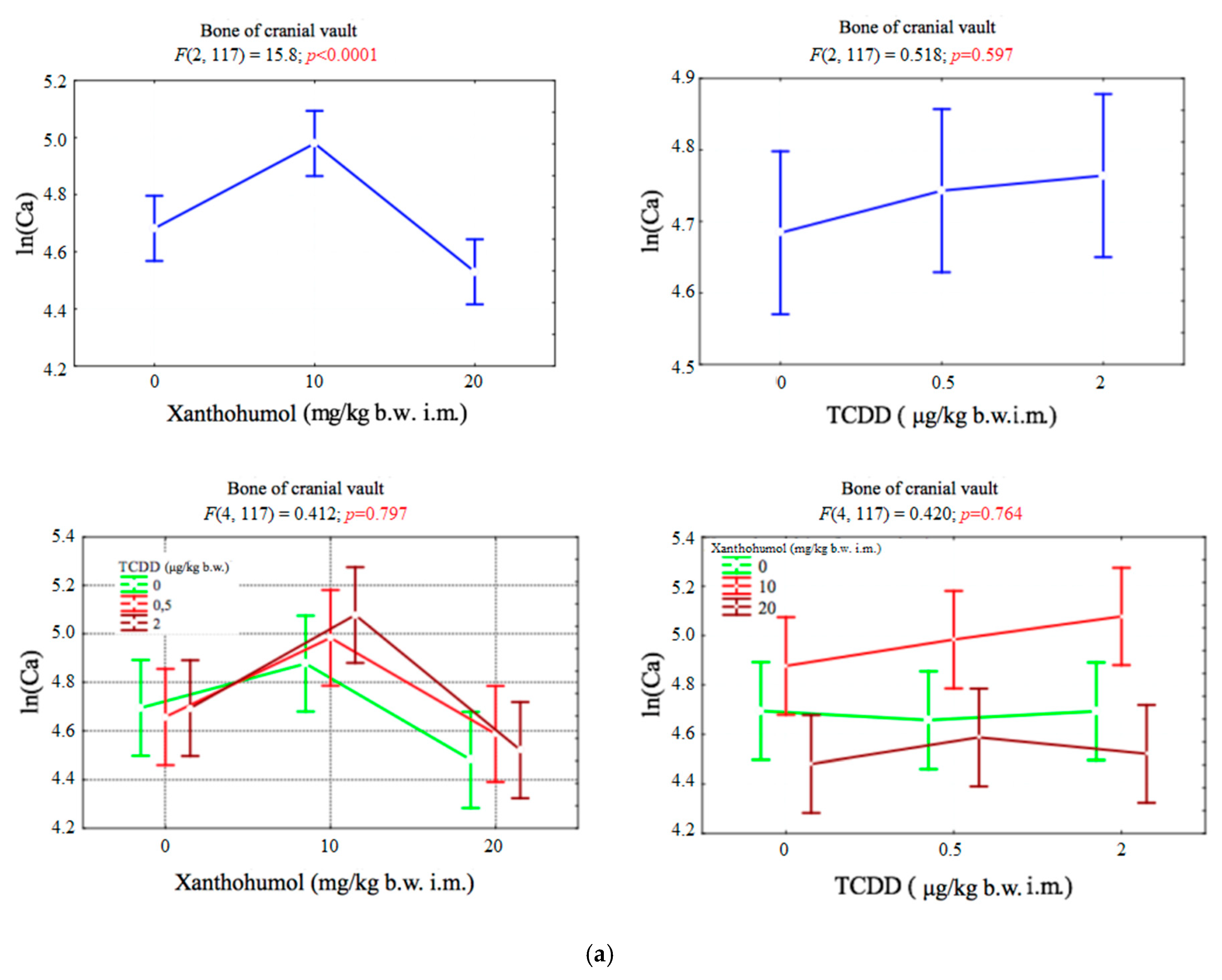
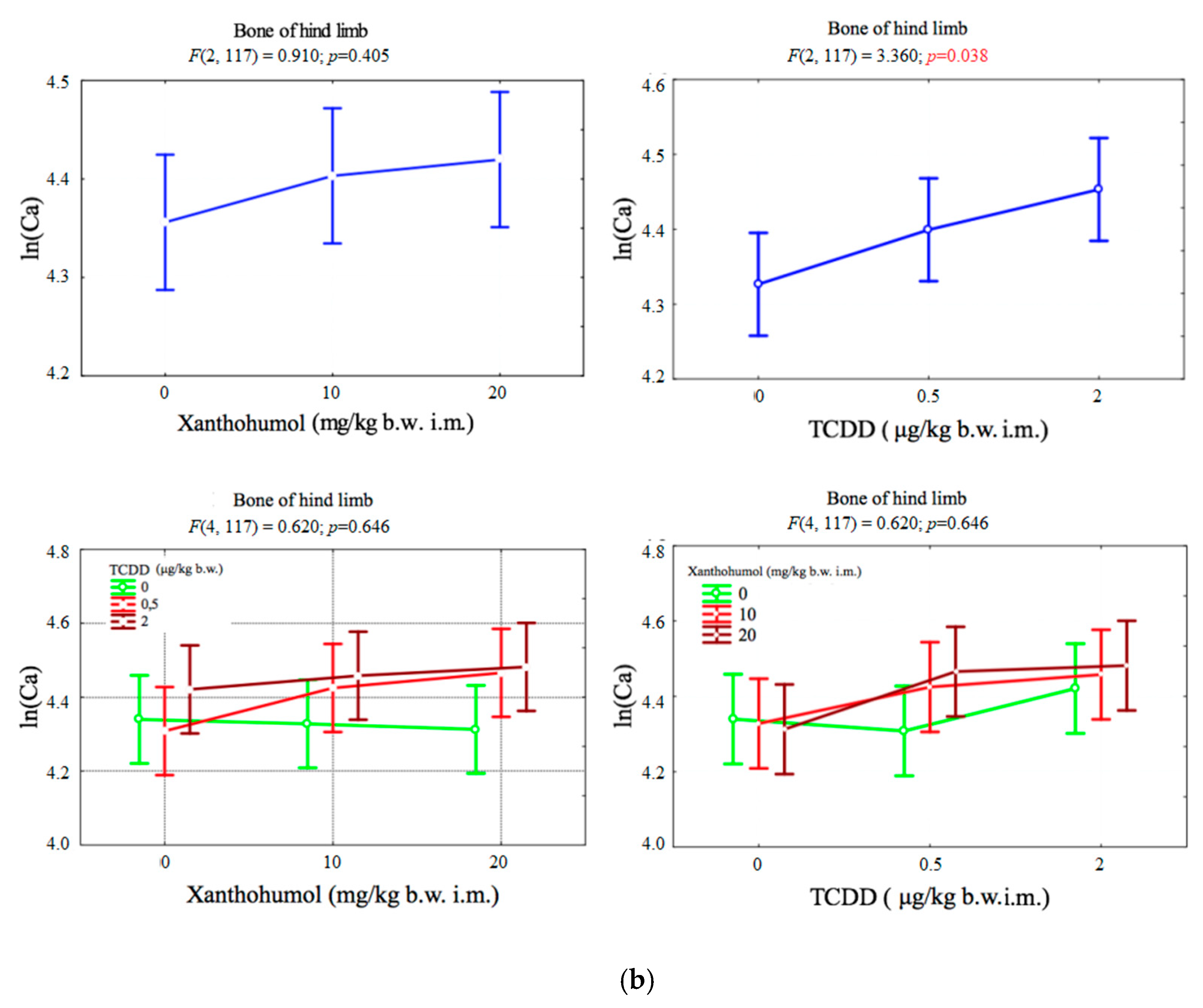
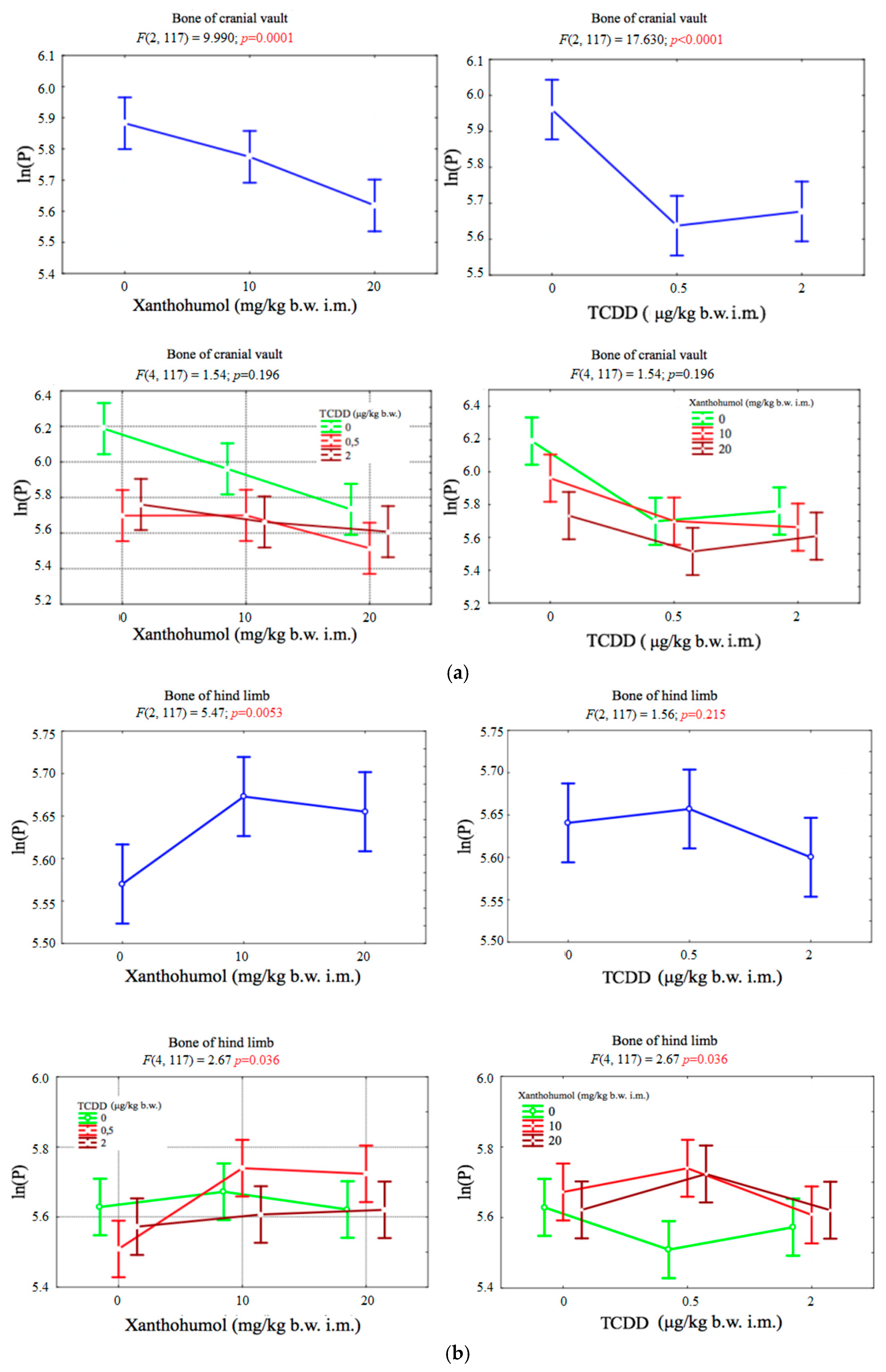
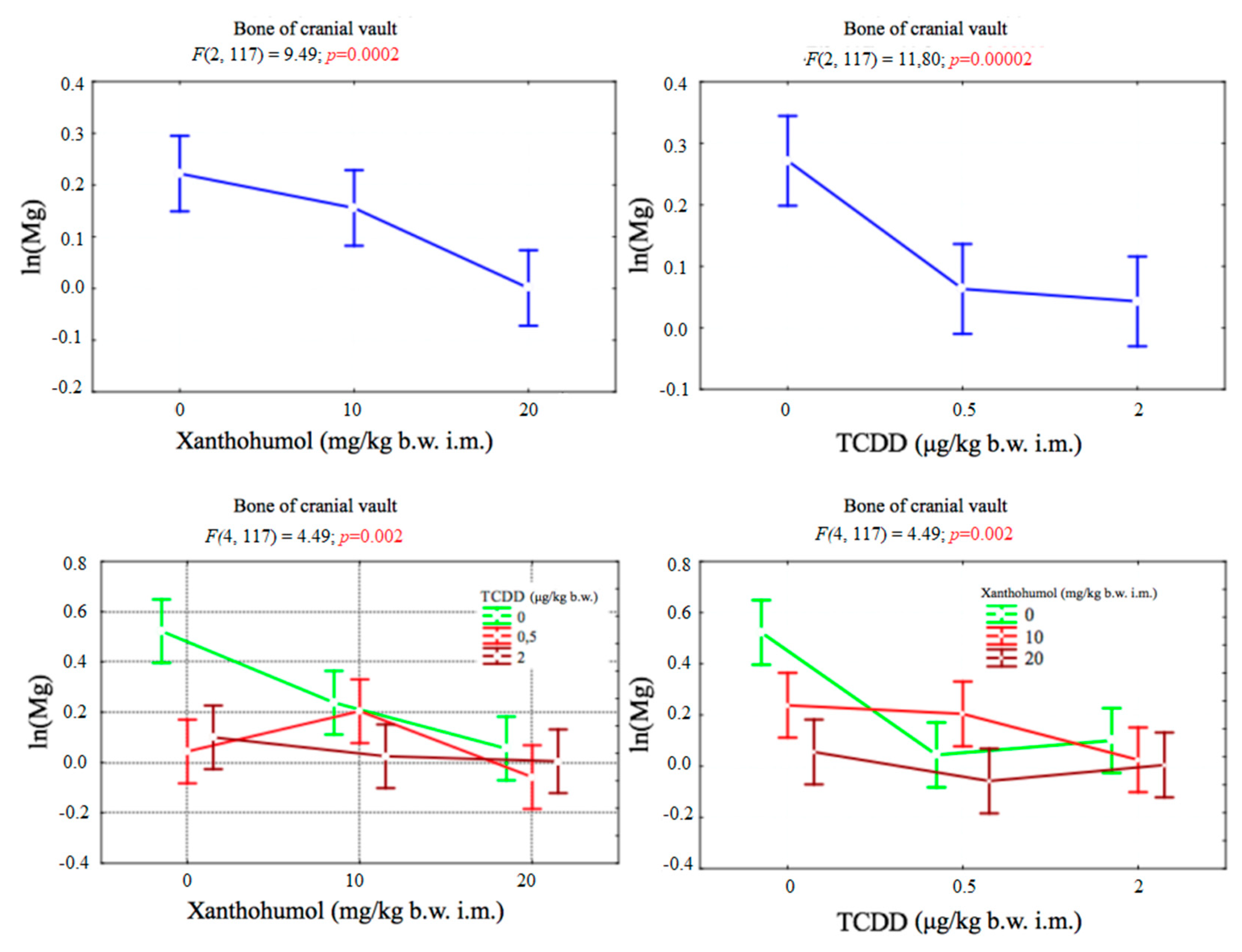

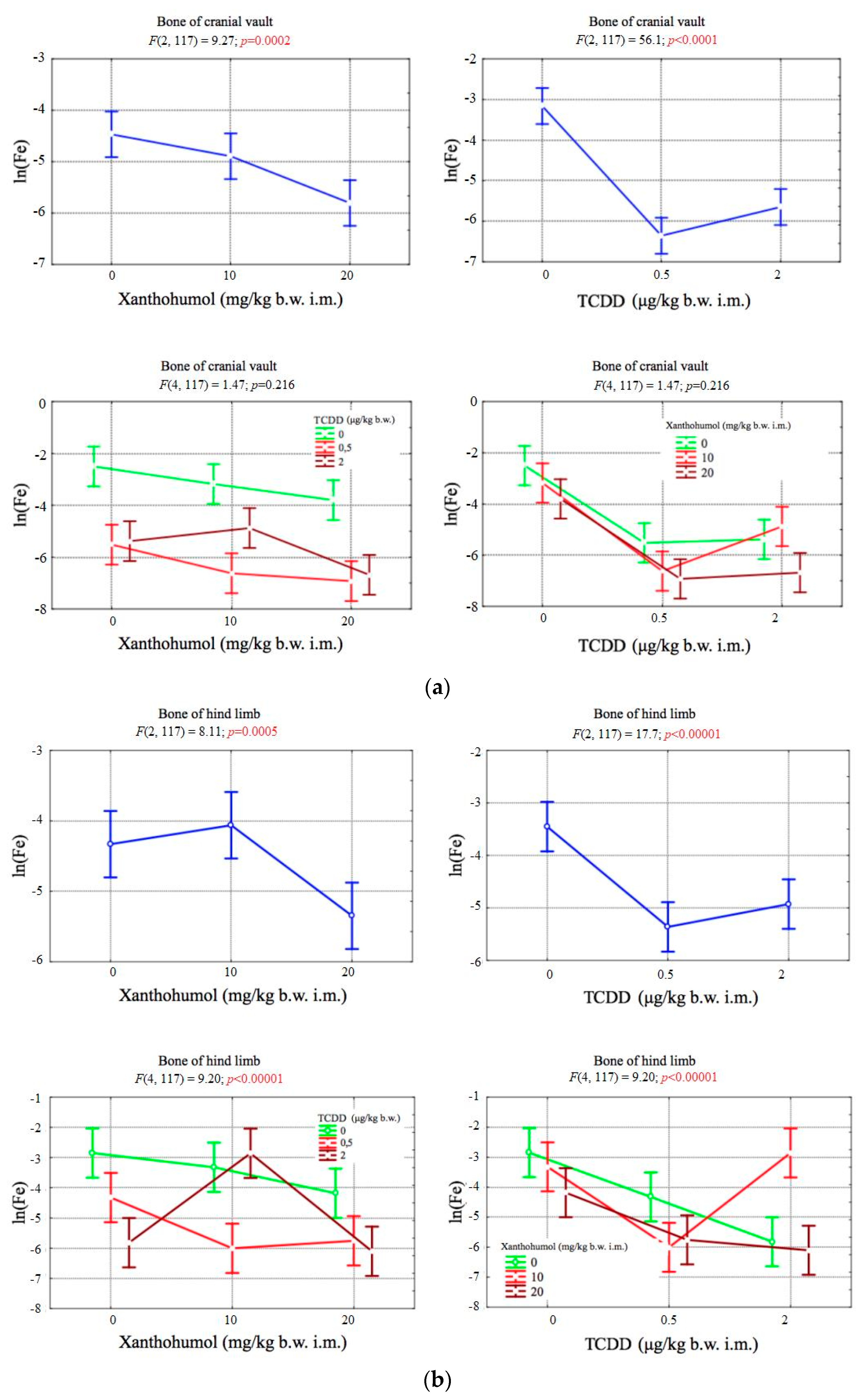
| Group Number | TCDD (ug/kg b.w. i.m.) | Xanthohumol (mg/kg b.w. i.m.) |
|---|---|---|
| I | 0 | 0 |
| II | 0 | 10 |
| III | 0 | 20 |
| IV | 0.5 | 0 |
| V | 0.5 | 10 |
| VI | 0.5 | 20 |
| VII | 2 | 0 |
| VIII | 2 | 10 |
| IX | 2 | 20 |
© 2020 by the authors. Licensee MDPI, Basel, Switzerland. This article is an open access article distributed under the terms and conditions of the Creative Commons Attribution (CC BY) license (http://creativecommons.org/licenses/by/4.0/).
Share and Cite
Całkosińska, A.; Dominiak, M.; Sobolewska, S.; Leśków, A.; Tarnowska, M.; Całkosiński, A.; Dobrzyński, M. The Protective Effect of Xanthohumol on the Content of Selected Elements in the Bone Tissue for Exposed Japanese Quails to TCDD. Int. J. Environ. Res. Public Health 2020, 17, 5883. https://doi.org/10.3390/ijerph17165883
Całkosińska A, Dominiak M, Sobolewska S, Leśków A, Tarnowska M, Całkosiński A, Dobrzyński M. The Protective Effect of Xanthohumol on the Content of Selected Elements in the Bone Tissue for Exposed Japanese Quails to TCDD. International Journal of Environmental Research and Public Health. 2020; 17(16):5883. https://doi.org/10.3390/ijerph17165883
Chicago/Turabian StyleCałkosińska, Aleksandra, Marzena Dominiak, Sylwia Sobolewska, Anna Leśków, Małgorzata Tarnowska, Aleksander Całkosiński, and Maciej Dobrzyński. 2020. "The Protective Effect of Xanthohumol on the Content of Selected Elements in the Bone Tissue for Exposed Japanese Quails to TCDD" International Journal of Environmental Research and Public Health 17, no. 16: 5883. https://doi.org/10.3390/ijerph17165883
APA StyleCałkosińska, A., Dominiak, M., Sobolewska, S., Leśków, A., Tarnowska, M., Całkosiński, A., & Dobrzyński, M. (2020). The Protective Effect of Xanthohumol on the Content of Selected Elements in the Bone Tissue for Exposed Japanese Quails to TCDD. International Journal of Environmental Research and Public Health, 17(16), 5883. https://doi.org/10.3390/ijerph17165883







